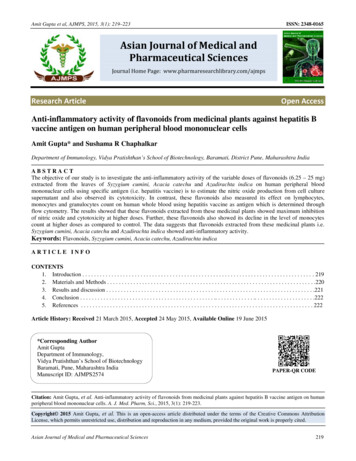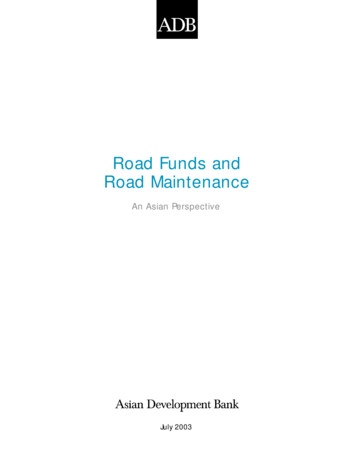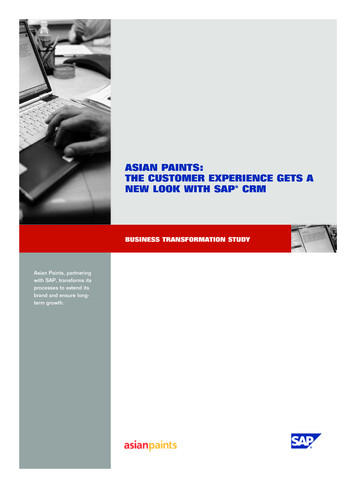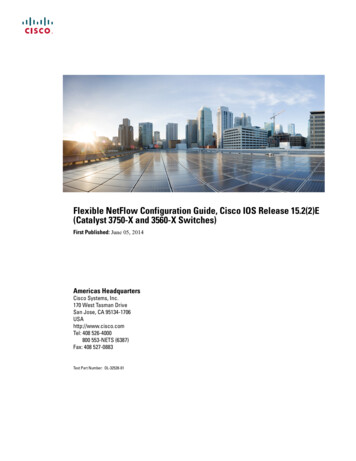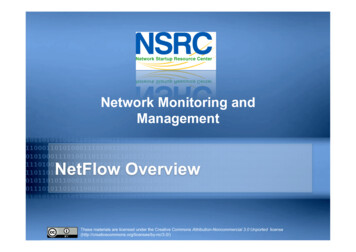
Transcription
Network Monitoring andManagementNetFlow OverviewThese materials are licensed under the Creative Commons Attribution-Noncommercial 3.0 Unported 3.0/)
Agenda1. Netflow- What it is and how it works- Uses and applications2. Generating and exporting flow records3. Nfdump and Nfsen- Architecture- Usage4. Lab
What is a Network Flow? A set of related packets Packets that belong to the same transportconnection. e.g.- TCP, same src IP, src port, dst IP, dst port- UDP, same src IP, src port, dst IP, dst port- Some tools consider "bidirectional flows", i.e.A- B and B- A as part of the same flowhttp://en.wikipedia.org/wiki/Traffic flow (computer networking)
Simple flows Packet belonging to flow X Packet belonging to flow Y
Cisco IOS Definition of a FlowUnidirectional sequence of packets sharing:1. Source IP address2. Destination IP address3. Source port for UDP or TCP, 0 for otherprotocols4. Destination port for UDP or TCP, type andcode for ICMP, or 0 for other protocols5. IP protocol6. Ingress interface (SNMP ifIndex)7. IP Type of Service
IOS: which of these six packetsare in the same flows?Src IPDst IPProtocolSrc PortDst PortA1.2.3.4 5.6.7.8 6 (TCP)400180B5.6.7.8 1.2.3.4 6 (TCP)804001C1.2.3.4 5.6.7.8 6 (TCP)400280D1.2.3.4 5.6.7.8 6 (TCP)400180E1.2.3.4 8.8.8.8 17 (UDP) 6543253F8.8.8.8 1.2.3.4 17 (UDP) 5365432
IOS: which of these six packetsare in the same flows?Src IPDst IPProtocolSrc PortDst PortA1.2.3.4 5.6.7.8 6 (TCP)400180B5.6.7.8 1.2.3.4 6 (TCP)804001C1.2.3.4 5.6.7.8 6 (TCP)400280D1.2.3.4 5.6.7.8 6 (TCP)400180E1.2.3.4 8.8.8.8 17 (UDP) 6543253F8.8.8.8 1.2.3.4 17 (UDP) 5365432What about packets “C” and “D”?
Flow AccountingA summary of all the packets seen in a flow(so far):-Flow identification: protocol, src/dst IP/port.Packet countByte countStart and end timesMaybe additional info, e.g. AS numbers,netmasksRecords traffic volume and type butnot content
Uses and ApplicationsYou can answer questions like:- Which user / department has been uploading /downloading the most?- Which are the most commonly-used protocolson my network?- Which devices are sending the most SMTPtraffic, and to where? Identification of anomalies and attacks More fine-grained visualisation (graphing)than can be done at the interface level
Working with flows1. Configure device (e.g. router) to generateflow accounting records2. Export the flows from the device (router) toa collector (PC)- Configure protocol version and destination3. Receive the flows, write them to disk4. Analyse the flowsMany tools available, both free and commercial
Where to generate flow records1. On a router or other network device- If the device supports it- No additional hardware required- Might have some impact on performance2. Passive collector (usually a Unix host)- Receives a copy of every packet andgenerates flows- Requires a mirror port- Resource intensive
Router CollectionLANLANLANLANflowrecordsInternetFlow collectorstores exported flows from router.
Router Collection All flows through router can be observed Router overhead to process & export flows Can select which interfaces Netflowcollection is needed and not activate it onothers If router on each LAN, Netflow can beactivated on them to reduce load on corerouter
Passive Monitor CollectionALLPACKETSWorkstation AflowrecordsWorkstation BFlow probe connectedto switch port in“traffic mirror” modeFlow collectorCampus
Passive CollectorExamples- softflowd (Linux/BSD)- pfflowd (BSD)- ng netflow (BSD) Collector sees all traffic through the networkpoint it is connected on and generates flows Relieves router from processing traffic,creating flows and exporting them
Passive Collector cont.Useful on links:- with only one entry into the network- where only flows from one section of thenetwork are neededCan be deployed in conjunction with an IDS
A thought:Your network probably already has a devicewhich is keeping track of IP addresses andport numbers of traffic flowing through it.What is it?
Flow Export Protocols Cisco Netflow, different versions- v5: widely deployed- v9: newer, extensible, includes IPv6 support IP Flow Information Export (IPFIX):- IETF standard, based on Netflow v9 sFlow: Sampling-based, commonly foundon switches jFlow: Juniper We use Netflow, but many tools supportmultiple protocols
Cisco Netflow Unidirectional flows IPv4 unicast and multicast- (IPv6 in Netflow v9) Flows exported via UDP- Choose a port. No particular standard,although 2055 and 9996 are commonly used Supported on IOS, ASA and CatOSplatforms - but with differentimplementations
Cisco IOS Configuration Configured on each input interface- modern IOS allows both input and output Define the version Define the IP address and port of thecollector (where to send the flows) Optionally enable aggregation tables Optionally configure flow timeout and main(v5) flow table size Optionally configure sample rate
Configuring Netflow: the old wayEnable CEF– ip cef!– ipv6 cef!Enable flow on each interfaceip route cache flow !OR!ip flow ingress!ip flow egress!Exporting Flows to a collector!ip flow-export version [5 9] [origin-as peer-as]!ip flow-export destination x.x.x.x udp-port
"Flexible Netflow": the new way Only way to monitor IPv6 flows on modernIOS Start using it now – IPv6 is coming / here Many mind-boggling options available, butbasic configuration is straightforward
Flexible netflow configuration Define one or more exportersflow exporter EXPORTER-1destination 192.0.2.99transport udp 9996source Loopback0template data timeout 300 Define one or more flow monitorsflow monitor FLOW-MONITOR-V4exporter EXPORTER-1cache timeout active 300record netflow ipv4 original-inputflow monitor FLOW-MONITOR-V6exporter EXPORTER-1cache timeout active 300record netflow ipv6 original-input
Flexible netflow configurationApply flow monitors to interfaceinterface GigabitEthernet0/0/0ip flow monitor FLOW-MONITOR-V4 inputip flow monitor FLOW-MONITOR-V4 outputipv6 flow monitor FLOW-MONITOR-V6 inputipv6 flow monitor FLOW-MONITOR-V6 output
"Top-talkers"You can summarize flows directly on therouter, e.g.show flow monitor FLOW-MONITOR-V4cache aggregate ipv4 source addressipv4 destination address sortcounter bytes top 20Yes, that's one long command!Old command "show ip flow top-talkers" sadlygone, but you could make an alias- conf t- alias exec top-talkers show flow.
Questions?
Collecting flows: nfdump Free and open source – Runs on collector nfcapd listens for incoming flow recordsand writes them to disk (flat files)- typically starts a new file every 5 minutes nfdump reads the files and turns them intohuman-readable output nfdump has command-line options to filterand aggregate the flows
nfdump architectureflowrecordsdaemonnfcapdflat filescommand linenfdumpDate flow start2013-04-18 13:35:23.3532013-04-18 13:35:23.3532013-04-18 13:48:21.3532013-04-18 ProtoUDPUDPTCPTCPSrc IP 38.180.96:611210.10.0.119:62099- - - - Dst IP 5Bytes Flows445259111.1 M120326150851
Analysing flows: nfsen Companion to nfdumpWeb GUICreates RRD graphs of traffic totalsLets you zoom in to a time of interest anddo nfdump analysis Manages nfcapd instances for you- Can run multiple nfcapd instances for listeningto flows from multiple routers Plugins available like port tracker, surfmap
nfsen architectureflowrecordsnfcapdflat files (every 5 minutes)ALLTCPUDPICMPotherfiltersumgraph
nfsen: points to note Every 5 minutes nfcapd starts a new file,and nfsen processes the previous one Hence each graph point covers 5 minutes The graph shows you the total of selectedtraffic in that 5-minute period To get more detailled information on theindividual flows in that period, the GUI letsyou drill down using nfdump
DemonstrationNow we will use nfsen to find biggest users ofbandwidth
Profiles and Channels A "channel" identifies a type of traffic tograph, and a "profile" is a collection ofchannels which can be shown together You can create your own profiles andchannels, and hence graphs. e.g. Total HTTP, HTTPS, SMTP traffic (etc) Traffic to and from the Science department . Use filters to define the traffic of interest
Profiles and el""Channel"HTTPHTTPSSMTPPOP3IMAPfiltersumgraph
References – Toolsnfdump and t/pmacct and w/flow-tools
References – Further Info WikiPedia:http://en.wikipedia.org/wiki/Netflow IETF standards rter.html Abilene NetFlow pagehttp://abilene-netflow.itec.oar.net/ Cisco Centric Open Source tml Cisco NetFlow Collector User Guidehttp://www.cisco.com/en/US/docs/net mgmt/netflow collection engine/6.0/tier one/user/guide/user.html
The end(Additional reference materials follow)
Filter examplesanyall trafficproto tcponly TCP trafficdst host 1.2.3.4only traffic to 1.2.3.4dst net 10.10.1.0/24only traffic to that rangenot dst net 10.10.1.0/24only traffic not to that rangeproto tcp and src port 80only TCP with source port 80dst net 10.10.1.0/24 or dst net 10.10.2.0/24only traffic to those netsdst net 10.10.1.0/24 and proto tcp and src port 80only HTTP response traffic to that net(dst net 10.10.1.0/24 or dst net 10.10.2.0/24) and proto tcp and src port 80.more complex combinations possible
Flows and Applications:More Examples
Uses for NetFlow Problem identification / solving– Traffic classification– DoS Traceback (some slides by DannyMcPherson) Traffic Analysis and Engineering– Inter-AS traffic analysis– Reporting on application proxies Accounting (or billing)– Cross verification from other sources– Can cross-check with SNMP data
Detect Anomalous Events: SQL“Slammer” Worm*
Flow-based Detection (cont)*Once baselines are built anomalous activity can bedetected– Pure rate-based (pps or bps) anomalies may be legitimateormalicious– Many misuse attacks can be immediately recognized, evenwithout baselines (e.g., TCP SYN or RST floods)– Signatures can also be defined to identify “interesting”transactional data (e.g., proto udp and port 1434 and 404octets(376 payload) slammer!)– Temporal compound signatures can be defined to detectwith higher precision
Flow-based Commercial Tools *
Commercial Detection: A Large ScaleDOS Attack
AccountingFlow based accounting can be a goodsupplement to SNMP basedaccounting.
Cisco Netflow Versions
NetFlow Version 1 Key fields: Source/Destination IP,Source/Destination Port, IP Protocol,ToS, Input interface. Accounting: Packets, Octets, Start/Endtime, Output interface Other: Bitwise OR of TCP flags. Does not have sequence numbers –no way to detect lost flows Obsolete
NetFlow Versions 2-4 Cisco internal Were never released
NetFlow v5 Key fields: Source/Destination IP,Source/Destination Port, IP Protocol,ToS, Input interface. Accounting: Packets, Octets, Start/Endtime, Output interface. Other: Bitwise OR of TCP flags,Source/Destination AS and IP Mask. Packet format adds sequencenumbers for detecting lost exports. IPv4 only
NetFlow v8 Aggregated v5 flows. Not all flow types available on allequipments Much less data to post process, butloses fine granularity of v5 – no IPaddresses.
NetFlow v9 IPv6 supportAdditional fields like MPLS labelsBuilds on earlier versionsPeriodically sends "template" packet, allflow data fields reference the template
- (IPv6 in Netflow v9) Flows exported via UDP - Choose a port. No particular standard, although 2055 and 9996 are commonly used Supported on IOS, ASA and CatOS platforms - but with



